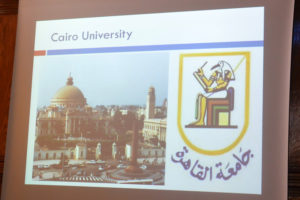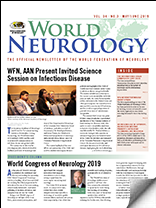WFN Training Center Report
By Wael Alwahchi
I would like thank WFN deeply; it was a good program that I hope will make a difference in my career, and change my future vision regarding neurology and the way of approaching and managing of neurological disorders.

My scientific trip started Jan. 5, 2018, when I arrived to the Kasr Al ainy Hospital. I was so impressed with regard to this old and historical place, which was big and great.
I met Dr. Husam Salah, a nice gentleman who was kind and welcomed me. He helped me to get settled regarding the accommodations.
The first week, I met the head of department and my supervisor, Prof. Mohamed El Tamawy and Prof. Maged Abdel Naseer, respectively, who provided a tour and introduced me to the staff of Kasr Al ainy.
My training program then started. I had rotations training in different subspecialties. My first three months targeted the Stroke Unit, where I was involved in the duties there, and I was also in the ER for one day. I also attended rounds in the ICU at the beginning of the week, and in the intermediate ICU at the end of the week. I was so impressed and satisfied in the discussions and management approach with Prof. Fouad Abdullah.
I saw a lot of cases of acute stroke management with rTPA and participated in post-stoke care. I was also in a variety of emergency neurological cases, such as myasthenic crisis, AIDP, SAH, coma, and stroke in the young.
I also had the opportunity to learn neurosonology, including carotid Doppler and transcranial Doppler, which were really interesting. Through this, I had the opportunity to understand vascular neurology more easily.
By the end, I was practicing how to assess a stroke patient using the NIHSS and recognized the indications for rTPA.
I then turned to the next subspecialty, which was epilepsy, where I spent about three months. I attended regularly epilepsy outpatient clinics, examined a huge number of patients and discussed the management plan and approach. I observed long-term EEG monitoring; at the beginning, it took time to understand the principles, but by the end, I found myself easily understanding EEG reporting and semiology of epilepsy. I also felt more confident dealing with pediatric epilepsy. I was involved in a variety of different cases of focal and generalized epilepsies, including Lennox Gastaut and JME. I then shifted to the multiple sclerosis unit for two months. I attended daily and learned how to treat acute exacerbations and how to manage symptomatic complaints and how to differentiate between multiple sclerosis and NMO. After finishing my MS rotation, I transferred to the neurophysiology department where I stayed for 55 days. I saw different neurological cases and observed nerve conduction studies and electromyography; during my first four weeks, I was an observer only, and then in the last two weeks, I was hands-on and participated in evaluating cases of carpal tunnel syndrome and repetitive nerve stimulation for myasthenia gravis.After finishing my rotation in neurophysiology, I rotated through movement disorders, dementia clinic, and general neurology.
I had an opportunity to attend most of continuing medical education programs, which were presented by different professors and lecturers, as well as the summer course, epilepsy school, multiple sclerosis conferences, and stroke and headache conferences.
In summary, it was a successful year! It was a nice experience, not easy, but I would like to thank all staff for helping me to finish my fellowship with success. The only concern is the delay of some official papers, which I hope will be resolved with the arrival of the next candidate. I will be so happy to help in sharing my experience for the next candidate.In the future, I hope to improve my hospital and construct a stroke unit, and raise our team of providers to the international levels.
Finally, in addition to my professors in Cairo, I would like to thank Mrs. Jade Roberts, Prof. Riadh Gouider, and Prof. William Carroll for their support. •
